
As the Queen of England, it’s widely assumed that she follows most of the rules. She’s known to impose quite strict rules on the rest of the royal family, but what does she actually think of royal protocols? Former First Lady of the United States, Michelle Obama, revealed an interesting story about the Queen in her autobiography “Becoming.”
In 2016, the Obamas were briefed on protocol before visiting the Queen and her husband, Prince Philip. Michelle would sit in the passenger seat next to the driver, the Prince himself, and Barack would sit next to the Queen in the backseat.
“After we’d touched down in a field on the palace grounds and said our hellos, however, the Queen abruptly threw a wrench into everything by gesturing for me to join her in the backseat of the Range Rover,” Michelle wrote. “I froze, trying to remember if anyone had prepped me for this scenario, whether it was more polite to go along with it or to insist that Barack take his proper seat by her side,” she added.
The queen, sensing Michelle’s confusion about the situation, assured her that it’s fine to break the rules. “Did they give you some rule about this?” the Queen asked Michelle, dismissing the fuss with the wave of her hand. “That’s rubbish. Sit wherever you want,” she told the then-first lady.
That’s not the only time the Queen has chosen to ignore protocol. She has broken quite a lot of rules throughout her reign.
In 2012, Queen Elizabeth issued Letters Patent that states that Prince William’s children would be styled as “HRH” and “Prince/Princess.” Before the decree, only a firstborn boy would automatically be called “Prince.” Prince George’s younger siblings, Princess Charlotte and Prince Louis, would have been styled as “Lady” and “Lord” under past rules.
For centuries, royal succession only followed eldest male children to succeed the throne regardless of the existence of female siblings. But in 2013, the Queen, with the help of the Parliament, passed the 2013 Succession to the Crown Act. It allowed future female royals, such as Charlotte, to ensure their place in line to the throne. The new law brought other benefits as well.
Due to the 2013 Act, only the first six royals (instead of all descendants of King George II) are required to have the Queen’s consent to marry. Before the law, Princess Eugenie (who’s ninth in line to the throne) would have had to get the approval of the Queen first to marry Jack Brooksbank.
It has been a rule since 1701 that a member of the royal family who marries a Roman Catholic loses his or her place in line to the throne. The 2013 Act changed that, and now royals can marry Roman Catholics without the risk of losing their spot in the line of succession.
In 2002, the Church of England (with the Queen as its Supreme Governor) allowed divorcees to remarry even while their former spouses are still alive. Because of this, Prince Charles got to marry Camilla Parker Bowles (divorced from Andrew Parker Bowles) in 2005.
Charles and Camilla wed in a civil ceremony. Given the history of their relationship, the Church felt that it was “inadvisable” for them to have a church wedding. But years later, the Queen permitted Prince Harry to marry divorcee Meghan Markle, and even the Church approved of them having a wedding ceremony in Westminster Abbey.
It’s a well-known rule not to initiate physical contact with any of the royal family when meeting them in person, but the Queen has let off this rule for a few times now. One instance was when she visited Canada House in London, and Canadian Governor General David Johnston touched the Queen’s arm to make sure that the Queen doesn’t lose her footing on the “slippy” red carpet.
Back in 2009, Michelle Obama broke another royal protocol with the Queen. Michelle gave her a light hug, and the Queen even returned the gesture. Michelle said that she wasn’t aware of the royal protocol at the time. “We were just two tired ladies oppressed by our shoes,” she shared in her autobiography “Becoming.”
© 2025 Latin Times. All rights reserved. Do not reproduce without permission.




